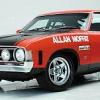-
Content Count
592 -
Joined
-
Last visited
-
Days Won
11
Reputation Activity
-
 Boingk reacted to deankxf in can anyone id this diff? SOLVED ( EA/EB wagon diff. 91DA part number... 3.27:1)
Boingk reacted to deankxf in can anyone id this diff? SOLVED ( EA/EB wagon diff. 91DA part number... 3.27:1)
if it has solid discs, it will be an E series diff(or XG)
if it has vented discs that you cant remove without pulling an axle out it will be pre XD(XC and possible XB)
if it has vented discs that can come off (one screw retains them) once the caliper is removed, and the caliper is Cast Iron, it will be XD diff.
if it's got vented discs and alloy calipers, it will be XE or XF diff.
that should be enough to id it.
EB onwards series also have a round flange for the tailshaft to bolt on, where upto EA had the 2 straps over the uni joints.
-
 Boingk got a reaction from LJDB in E1 valve stem seals.
Boingk got a reaction from LJDB in E1 valve stem seals.
Hi mate, the seals float with the valve stems. These ones will look like little rubber collars with metal band keeping them on the stem, yeah?
If they're still present and not cracked then they should be fine.
You can also use standard umbrella type seals, they come in a topend gasket kit for about 60 bucks total.
-
 Boingk got a reaction from CHESTNUTXE in CLEVELAND ENGINE TALK
Boingk got a reaction from CHESTNUTXE in CLEVELAND ENGINE TALK
Wow @gerg looks like you caught that in the nick of time. Good work on figuring out the shims, that'll definitely set you up nicely.
For the aircraft, it was a Gardan Minicab built in 1969 and powered by a 1940 model Continental A65-8; an air-cooled 170ci flat four for non aircraftians. It had twin Bendix magnetos and no starter, so I had to hand prop it. Because it was a low winger I stood in front of the prop. Generally started second or third flip, stupidly satisfying!
-
 Boingk got a reaction from CHESTNUTXE in CLEVELAND ENGINE TALK
Boingk got a reaction from CHESTNUTXE in CLEVELAND ENGINE TALK
Wow @gerg looks like you caught that in the nick of time. Good work on figuring out the shims, that'll definitely set you up nicely.
For the aircraft, it was a Gardan Minicab built in 1969 and powered by a 1940 model Continental A65-8; an air-cooled 170ci flat four for non aircraftians. It had twin Bendix magnetos and no starter, so I had to hand prop it. Because it was a low winger I stood in front of the prop. Generally started second or third flip, stupidly satisfying!
-
 Boingk got a reaction from CHESTNUTXE in CLEVELAND ENGINE TALK
Boingk got a reaction from CHESTNUTXE in CLEVELAND ENGINE TALK
Wow @gerg looks like you caught that in the nick of time. Good work on figuring out the shims, that'll definitely set you up nicely.
For the aircraft, it was a Gardan Minicab built in 1969 and powered by a 1940 model Continental A65-8; an air-cooled 170ci flat four for non aircraftians. It had twin Bendix magnetos and no starter, so I had to hand prop it. Because it was a low winger I stood in front of the prop. Generally started second or third flip, stupidly satisfying!
-
 Boingk got a reaction from CHESTNUTXE in CLEVELAND ENGINE TALK
Boingk got a reaction from CHESTNUTXE in CLEVELAND ENGINE TALK
Wow @gerg looks like you caught that in the nick of time. Good work on figuring out the shims, that'll definitely set you up nicely.
For the aircraft, it was a Gardan Minicab built in 1969 and powered by a 1940 model Continental A65-8; an air-cooled 170ci flat four for non aircraftians. It had twin Bendix magnetos and no starter, so I had to hand prop it. Because it was a low winger I stood in front of the prop. Generally started second or third flip, stupidly satisfying!
-
 Boingk got a reaction from CHESTNUTXE in CLEVELAND ENGINE TALK
Boingk got a reaction from CHESTNUTXE in CLEVELAND ENGINE TALK
Wow @gerg looks like you caught that in the nick of time. Good work on figuring out the shims, that'll definitely set you up nicely.
For the aircraft, it was a Gardan Minicab built in 1969 and powered by a 1940 model Continental A65-8; an air-cooled 170ci flat four for non aircraftians. It had twin Bendix magnetos and no starter, so I had to hand prop it. Because it was a low winger I stood in front of the prop. Generally started second or third flip, stupidly satisfying!
-
 Boingk got a reaction from gerg in CLEVELAND ENGINE TALK
Boingk got a reaction from gerg in CLEVELAND ENGINE TALK
Can't argue there mate.
Most Pentrite oils I use tend to boast 1200ppm+ ZDDP levels, which seems decent in my book. I particularly like their HPR30, a 20W-60 weight mineral oil. It might sound antiquated but I ran it in my fully instrumented, Continental-engined aircraft and it was a winner. Didn't discolour, didn't break down with heat, didn't lose oil pressure on hot climbs or hot idle, and allowed me to use full throttle judiciously. Nothing else I tried even came close. And this was with an extended oil drain interval, too!
Hope the roller conversion goes well!
- boingk
-
 Boingk got a reaction from bear351c in Ford Xf Fairmont Ghia (Papou) - Rebuild/Help
Boingk got a reaction from bear351c in Ford Xf Fairmont Ghia (Papou) - Rebuild/Help
Hi mate, I'd recommend a nice mild street cam for most applications, something about 205 to 215 duration @.050" and 450 to 500 lift. I had a similar part in my Cleveland and it was a hoot, very linear and nice to drive. Something like the 14776 or 14892 from Crow Cams. Descriptions tend to go something like "Great midrange performance, suit mild street engine," with and rpm range about 1500 to 4500 or so.
If you're after something to work with stock EFI you're going to be limited. The duration, lobe centres and overlap tend to want to stay the same, you can increase lift a bit but will be limited by the other parameters. The 14221 does indeed looks to fit most of the criteria as its on the same 109 deg lobe sep angle and has very similar overall durations (270 vs 260), with only mildly extended duration @.050 (205 vs 197), whilst lift is improved nicely (470+ vs 439).
If you're dead set on retaining everything original the EFI will limit you, consider an EFI box... or even going back to a good aftermarket carby.
- boingk
-
 Boingk got a reaction from bear351c in Ford Xf Fairmont Ghia (Papou) - Rebuild/Help
Boingk got a reaction from bear351c in Ford Xf Fairmont Ghia (Papou) - Rebuild/Help
Hi mate, I'd recommend a nice mild street cam for most applications, something about 205 to 215 duration @.050" and 450 to 500 lift. I had a similar part in my Cleveland and it was a hoot, very linear and nice to drive. Something like the 14776 or 14892 from Crow Cams. Descriptions tend to go something like "Great midrange performance, suit mild street engine," with and rpm range about 1500 to 4500 or so.
If you're after something to work with stock EFI you're going to be limited. The duration, lobe centres and overlap tend to want to stay the same, you can increase lift a bit but will be limited by the other parameters. The 14221 does indeed looks to fit most of the criteria as its on the same 109 deg lobe sep angle and has very similar overall durations (270 vs 260), with only mildly extended duration @.050 (205 vs 197), whilst lift is improved nicely (470+ vs 439).
If you're dead set on retaining everything original the EFI will limit you, consider an EFI box... or even going back to a good aftermarket carby.
- boingk
-
 Boingk got a reaction from CHESTNUTXE in XR6 6 speed manual into XF?
Boingk got a reaction from CHESTNUTXE in XR6 6 speed manual into XF?
Hey gents, quick question...
...will an XR6 6-speed manual box fit up to an XF with a crossflow 6cyl?
I have the option to buy one locally for cheap so figured it may be worth it.
-
 Boingk got a reaction from gerg in CLEVELAND ENGINE TALK
Boingk got a reaction from gerg in CLEVELAND ENGINE TALK
Yep, they sound good alright. This was my Effy:
-
 Boingk got a reaction from gerg in CLEVELAND ENGINE TALK
Boingk got a reaction from gerg in CLEVELAND ENGINE TALK
Yep, they sound good alright. This was my Effy:
-
 Boingk reacted to gerg in CLEVELAND ENGINE TALK
Boingk reacted to gerg in CLEVELAND ENGINE TALK
All great points, I'll add to/elaborate on the many reasons why the US Clevo died in 74:
They were a heavier engine. The 351W was slightly lighter despite having a taller deck.
The word "performance" for all manufacturers was becoming a forbidden word. A major key to the racy 351C, the 4V head (what made it a performance engine) was becoming redundant because performance was way down the list of priorities, and was of no advantage with all the smog requirements of the time.
The federal laws in advertising engine horsepower had to be shown in DIN or net (ie: as installed in the vehicle) as opposed to the bullshit SAE figures they used to get with no water pump, alternator or exhaust system. Finally, people could see the inefficiency of the big lumps they were driving, some down by 100 HP with no changes to the tune. For the fuel they used, they provided poor performance.
Efficiency is another good point, one well made by Boingk, was the open-chamber design that was better for emissions but worse for efficiency. The new laws pushing from one end and the fuel crisis from the other put the squeeze on manufacturers to cull the worst performing designs and focus on engineering the ones left into a feasible product.
They were somewhat able to recoup the development cost of the Cleveland by continuing to build the 351M/400, an evolution of the Clevo but used in large cars and trucks. This range continued until 1982. It was a low-power, high-torque smog motor, a replacement for the 390.
The cars coming out at the time were too small to take the large, heavy lump that the clevo was. The Mustang and the Pinto were going to be their bread-and butter models, which were 4 and 6-cylinder powered. Although, they did manage to wedge a smogged 302W into the last model of the Mustang II before the Fox came out.
What eventually killed the 351M/400 was the difficulty in adapting to the new emissions standards of the 1980s, which required feedback via oxygen sensors which are (for obvious reasons) incompatible with air pump injection systems. Coupled with the reduced demand for an engine of that size in the lean-and-mean 80s, the cost of re-engineering the "M" motor was not justifiable.
The reasons why the Cleveland continued in Aus right until the end of 82 was the fact that large family cars were still popular at the time. The Cleveland was already engineered for fitment into the Falcon/Fairlane chassis so there was no problem continuing that line, even if on a small scale. The tooling had already been made, so the rest was just production cost.
Of course Ford pulled the pin in 82 and paid for it until the bitter end, but that's a whole new essay for another day.
Sent from my CPH1607 using Tapatalk
-

-
 Boingk got a reaction from CHESTNUTXE in CLEVELAND ENGINE TALK
Boingk got a reaction from CHESTNUTXE in CLEVELAND ENGINE TALK
At those prices I'd be getting an older block hot tanked and machined. Hell, I put 302C heads on my 351C in an F350 and with a mild cam and 4bbl it went like hell!
A big part of the reason they got killed was the looming 1976 emissions standard for US and in particular California which is notoriously strict. Part of the design of a Clevo is that it has inefficient low velocity ports and in open-chamber style produces poor power with mediocre emissions... albeit better than the closed chamber heads. Add to this its oddly low 1st piston ring, causing a thin ring of hard-to-ignite vapour mix, and you've got an emissions disaster by any standard.
Also, the contemporaneously popular style of emissions regulations were not easily integrated into the Cleveland castings. These tended to be things like exhaust gas recirculation (EGR) and air-injection into the exhaust ports to encourage thorough burning of any remaining unignited mixture being expelled. With a short production run slated mainly for performance options and larger luxury cars, the Cleveland was replaced by the Windsor in most applications and quietly killed off.
Another aspect to this was management. Apparently the head of development at the time the Cleveland went into production was somewhat of a mover 'n' shaker, and was an influencing factor in getting the project not only off the ground, but into production cars. As with many things, this quickly changed with new management, plus the aforementioned emissions standards and the Arab Emirates fuel crisis in 1972 inspiring a move away from larger capacity engines.
Shame, they were pretty much the LS motor of their day, they just couldn't be efficiently adapted to meet regulations.
- boingk
-
 Boingk got a reaction from CHESTNUTXE in Nitrous
Boingk got a reaction from CHESTNUTXE in Nitrous
Depends on what sort of power you want. Not legal on the street, but if its bolt-on powerfor the strip you want you won't get much better bang for the buck. Look at Nitrous Express's ML1000 'Mainline' kit, its a billet plate injection system rated for 250hp out of the box, and comes with smaller jets as well. It comes with most things for a basic working setup but you'll want a full-throttle activation switch and arming solenoid, plus a master arming flip-switch in the cabin.
- boingk
-
 Boingk got a reaction from CHESTNUTXE in CLEVELAND ENGINE TALK
Boingk got a reaction from CHESTNUTXE in CLEVELAND ENGINE TALK
At those prices I'd be getting an older block hot tanked and machined. Hell, I put 302C heads on my 351C in an F350 and with a mild cam and 4bbl it went like hell!
A big part of the reason they got killed was the looming 1976 emissions standard for US and in particular California which is notoriously strict. Part of the design of a Clevo is that it has inefficient low velocity ports and in open-chamber style produces poor power with mediocre emissions... albeit better than the closed chamber heads. Add to this its oddly low 1st piston ring, causing a thin ring of hard-to-ignite vapour mix, and you've got an emissions disaster by any standard.
Also, the contemporaneously popular style of emissions regulations were not easily integrated into the Cleveland castings. These tended to be things like exhaust gas recirculation (EGR) and air-injection into the exhaust ports to encourage thorough burning of any remaining unignited mixture being expelled. With a short production run slated mainly for performance options and larger luxury cars, the Cleveland was replaced by the Windsor in most applications and quietly killed off.
Another aspect to this was management. Apparently the head of development at the time the Cleveland went into production was somewhat of a mover 'n' shaker, and was an influencing factor in getting the project not only off the ground, but into production cars. As with many things, this quickly changed with new management, plus the aforementioned emissions standards and the Arab Emirates fuel crisis in 1972 inspiring a move away from larger capacity engines.
Shame, they were pretty much the LS motor of their day, they just couldn't be efficiently adapted to meet regulations.
- boingk
-
 Boingk got a reaction from CHESTNUTXE in CLEVELAND ENGINE TALK
Boingk got a reaction from CHESTNUTXE in CLEVELAND ENGINE TALK
At those prices I'd be getting an older block hot tanked and machined. Hell, I put 302C heads on my 351C in an F350 and with a mild cam and 4bbl it went like hell!
A big part of the reason they got killed was the looming 1976 emissions standard for US and in particular California which is notoriously strict. Part of the design of a Clevo is that it has inefficient low velocity ports and in open-chamber style produces poor power with mediocre emissions... albeit better than the closed chamber heads. Add to this its oddly low 1st piston ring, causing a thin ring of hard-to-ignite vapour mix, and you've got an emissions disaster by any standard.
Also, the contemporaneously popular style of emissions regulations were not easily integrated into the Cleveland castings. These tended to be things like exhaust gas recirculation (EGR) and air-injection into the exhaust ports to encourage thorough burning of any remaining unignited mixture being expelled. With a short production run slated mainly for performance options and larger luxury cars, the Cleveland was replaced by the Windsor in most applications and quietly killed off.
Another aspect to this was management. Apparently the head of development at the time the Cleveland went into production was somewhat of a mover 'n' shaker, and was an influencing factor in getting the project not only off the ground, but into production cars. As with many things, this quickly changed with new management, plus the aforementioned emissions standards and the Arab Emirates fuel crisis in 1972 inspiring a move away from larger capacity engines.
Shame, they were pretty much the LS motor of their day, they just couldn't be efficiently adapted to meet regulations.
- boingk
-
 Boingk got a reaction from CHESTNUTXE in CLEVELAND ENGINE TALK
Boingk got a reaction from CHESTNUTXE in CLEVELAND ENGINE TALK
At those prices I'd be getting an older block hot tanked and machined. Hell, I put 302C heads on my 351C in an F350 and with a mild cam and 4bbl it went like hell!
A big part of the reason they got killed was the looming 1976 emissions standard for US and in particular California which is notoriously strict. Part of the design of a Clevo is that it has inefficient low velocity ports and in open-chamber style produces poor power with mediocre emissions... albeit better than the closed chamber heads. Add to this its oddly low 1st piston ring, causing a thin ring of hard-to-ignite vapour mix, and you've got an emissions disaster by any standard.
Also, the contemporaneously popular style of emissions regulations were not easily integrated into the Cleveland castings. These tended to be things like exhaust gas recirculation (EGR) and air-injection into the exhaust ports to encourage thorough burning of any remaining unignited mixture being expelled. With a short production run slated mainly for performance options and larger luxury cars, the Cleveland was replaced by the Windsor in most applications and quietly killed off.
Another aspect to this was management. Apparently the head of development at the time the Cleveland went into production was somewhat of a mover 'n' shaker, and was an influencing factor in getting the project not only off the ground, but into production cars. As with many things, this quickly changed with new management, plus the aforementioned emissions standards and the Arab Emirates fuel crisis in 1972 inspiring a move away from larger capacity engines.
Shame, they were pretty much the LS motor of their day, they just couldn't be efficiently adapted to meet regulations.
- boingk
-
 Boingk got a reaction from ando76 in Boingk's 1/4 Mile Crossflow Build
Boingk got a reaction from ando76 in Boingk's 1/4 Mile Crossflow Build
Thanks mate, that's reassuring and timely as I was actually looking at something similar to use as a daily with the motor currently in the ute. I'll have a read of your thread for reference.
I guess the things going in my favour are that the ute is currently (and will remain) manual, and I'm investing time to set it up properly re valvetrain, diff ratio, etc. Realistically I suppose I can probably run a lot more cam than I am looking at.
Rule number 1 with the bullet for this is to keep it reliable and practical as a daily driver. I live in the middle of nowhere and can't afford a breakdown due to something I can't remedy on the roadside with basic tools. I tend to have a 'breakdown bucket' at all times, literally a plastic bucket with spanners, screwdrivers, shifters and vice grips, wire, zipties and duct tape, a spare fuel pump and spark plugs, plus fuel filter, JB weld and extra oil. If I can't fix what happened with that then I guess its put the broken bit in the bucket and hitch a ride time.
Cheers all, and Merry Christmas!
-
 Boingk reacted to FORD_MAN in Boingk's 1/4 Mile Crossflow Build
Boingk reacted to FORD_MAN in Boingk's 1/4 Mile Crossflow Build
Don't be overly worried about how driveable with that size of cam(235-241), i was & found was worried about nothing.
my XF utes untuned QFT 600V/S with Camtech 237@0.050" 550" 108LSA hyd cam, stock auto 2.92 diff, and still drives around as nice as when it had the old engine in it,
-
 Boingk reacted to Fingers in Best way to achieve correct compression ratio
Boingk reacted to Fingers in Best way to achieve correct compression ratio
Drive a modern turbo engine for evidence of what Slydog is talking about.
Instant torque and a perfectly flat torque curve (plateau/table?) from about 1500 rpm (under stall speed) to 4 or 5 thousand rpm.
Perfect drivability with great fuel economy, win win.
-
 Boingk reacted to slydog in Best way to achieve correct compression ratio
Boingk reacted to slydog in Best way to achieve correct compression ratio
Turbos are odd things and Im not on board my self but Dans LS Centura with Chinee turbo but sized right has ZERO lag. Like powerskids from idle to max rpm in top long as you can from a standing start like your doing a brake skid.
Get the exhuast on the smaller side and it will still make the hp and make it such a better deal...IMO based on stuff that actually works on real cars not internet talk.
-
 Boingk reacted to slydog in Best way to achieve correct compression ratio
Boingk reacted to slydog in Best way to achieve correct compression ratio
Compression won't kill a engine,tune will. Barras and 2js run over 10 comp. Need to talk to people who build other engines not just xflows to go forward. Or be stuck with a VHS player if you get my drift.
Aus fastest RBs run more comp than you think too. My xflow runs 11.2 comp and has seen 10psi @ 7500rpm with a big cam and big cyl head. On a small or stock headed combo with a small cam it would show ALOT more boost but wouldn't make the same hp.Boost is only a measurement of inlet restriction after all. So a bigger head with less restriction means it shows less boost but makes more hp and you use more comp which means little to no lag time if turbo is sized right.







